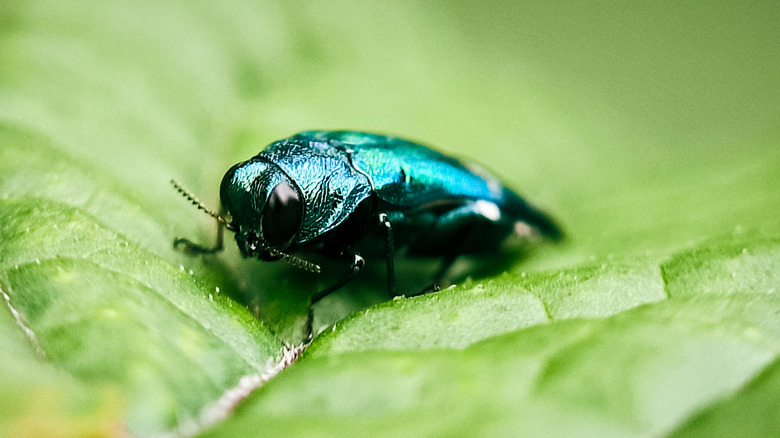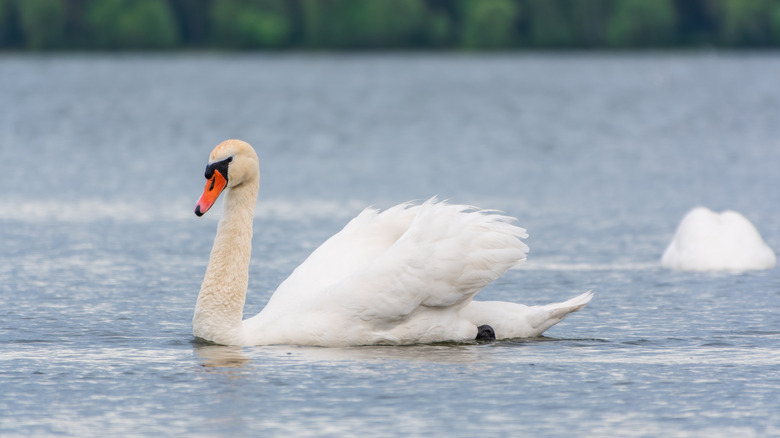5 Invasive Species That Are Wreaking Havoc In Indiana
We might not think about it all that often, but the United States has some serious issues with invasive species. The country is home to more than 6,500 invasive species, and the USDA's National Invasive Species Information Center is unable to track all of them, simply due to their sheer volume.
Though this is a national problem, some states are more affected than others. Texas is in the midst of being destroyed by an invasive species in the form of wild hogs, which are now in 99.6% of the state's 254 counties and are causing all manner of issues, from property destruction to the degradation of ecosystems. Meanwhile, South Florida is overrun by Burmese pythons, which are not native to the U.S. but were either released or escaped from captivity after everybody decided it would be cool to own one of these deadly constrictors during the '90s.
While Texas and Florida have their major issues with invaders, one state that is also struggling with unwanted invaders is Indiana. In a 2023 report, the Indiana Invasive Species Council warned that the list of invasive species in the state "continues to grow at an alarming rate" and estimated that invaders had a fiscal impact of around $17.5 billion annually on Indiana. From plants and animals to insects, the state is fighting a battle against these unwelcome visitors. Here are five that are wreaking havoc.
Poison hemlock
It might look innocuous, perhaps even quite beautiful, but as its name suggests, poison hemlock is a toxic invasive plant. Often found along roads, streams, trails, and at the edges of forests, poison hemlock contains alkaloid compounds that can be fatal to animals and humans. The plant typically grows to a height of between 3 and 10 feet, and it can be easily mistaken for wild parsnips or Queen Anne's lace. However, the entirety of this invasive plant species is poisonous, especially the seeds, which contain the highest concentration of poison. Sap from the plant can cause blisters and welts on human skin, but the real danger comes if any part of the plant is ingested. Human deaths have even been recorded as a result of individuals harvesting and eating the roots.
Initially growing in Europe, poison hemlock was intentionally brought to North America to be used in gardens and found its way into Indiana around 2016. Aside from posing a toxic threat to wildlife, this particular invader can displace native plant species, with each hemlock plant producing as many as 30,000 seeds which can scatter during late summer.
In 2021, the IndyStar reported that poison hemlock was becoming even more of an issue, having migrated to parks, flower beds, and gardens in what Dan Shaver from the Natural Resources Conservation Service called an "exponential rate of spread." Shaver said that the plant's migration was "a bit scary" because "this plant is very toxic and it's more of an opportunity for kids to play with it and pets to eat it. It is not a plant you want around your home or in your local park." At this stage, the plant has spread too much within Indiana to be entirely removed, but urgent action is clearly required.
Emerald ash borer
As its name suggests, the emerald ash borer feeds on ash trees and has thus far wiped out huge swathes of the trees in Indiana. First discovered in the U.S. in 2002, the exotic beetle is originally from Asia and found its way to Indiana in 2004. It has since spread throughout the state and surrounding areas, becoming nothing short of a scourge as it digs into ash trees, deposits larvae, and ultimately kills the host plant. In 2017, arborists estimated the beetle had already wiped out tens of thousands of trees, and the problem hasn't improved much since. This led Purdue University to refer to the species as "one of the most damaging insect pests ever to invade North American forests."
The green beetles, no bigger than a grain of rice, are actually quite alluring in terms of their appearance, with a shiny metallic outer shell. Sadly, their look belies a truly relentless appetite that has had a devastating effect on Indiana, where the species has been present in all 92 counties for some time, prompting restrictions on moving firewood and ash wood within the state.
Invasive species don't only endanger other organisms and damage ecosystems; they can cause untold economic damage, too. In the emerald ash borer's case, aside from wiping out trees and damaging ecosystems as a result, the dead and dying ash trees are a significant hazard in and of themselves. As Purdue points out, these damaged trees are brittle enough to break and drop branches on people and property, meaning the emerald ash borer poses both a safety and economic risk to the state.
Spongy moth
The spongy moth is native to Europe and Asia but found its way to the U.S. all the way back in the late 1860s when an amateur entomologist introduced the pest to an area near Boston. It's since spread westward, and some 160 years later, the Indiana Department of Natural Resources refers to spongy moths, once known as gypsy moths, as "one of North America's most devastating invasive forest pests"— and for good reason. As Purdue University notes, in 2021, this invasive species defoliated more than 9 million acres of forest in the U.S.
First recorded in Indiana in 1998, the insect has now spread to most northern counties and areas in the state. Known to feed on the foliage of more than 500 species of trees and shrubs, this insect has a particular penchant for oak trees, which it devours when it is in its caterpillar stage. While defoliating a tree doesn't always lead to the death of that tree, other factors such as drought, disease, or poor growing conditions could combine with the spongy moths' efforts to kill off the trees. What's more, defoliation over two to four years can lead to a tree's death.
Spongy moths spread when caterpillars crawl to the tops of trees and are blown by the wind. Humans can spread the insects, too, by unintentionally moving surfaces that contain eggs. So far, Indiana has been able to contain this invader somewhat, but if allowed to get out of control, the spongy moth could prove devastating for the state's forests — and all because of one individual in the 1860s.
Asian carp (invasive carp)
Indiana is enduring an ongoing invasion by a group of carp collectively known as Asian carp, or Invasive carp. The group comprises bighead carp, silver carp, grass carp, and black carp, all of which were intentionally released into the U.S. but have collectively come to be considered an invasive species. These carp were initially used by aquaculture and wastewater treatment facilities to help keep retention ponds clean, ridding them of algae and algal blooms due to the way to the fish open and close their mouths as they swim. Lamentably, the fish eventually found their way into the Mississippi river system due to flooding and accidental releases, and they have been wreaking havoc ever since.
Now found in the Ohio, White, and Wabash rivers, the invasive fish threaten already endangered species, reproducing at a rapid rate and having a hugely detrimental effect on other existing fish in the ecosystems in which they're present. The carp also have a voracious appetite, with adults able to eat up to 40% of their body weight every single day. Unsurprisingly, this has led to major changes in the food chains of various water habitats as Asian carp devour all the algae and zooplankton that other native species also rely on to survive. Efforts to control the carp numbers are somewhat futile, too, as adult females are capable of laying up to 1 million eggs per year, and only a fraction of those need to hatch in order to outpace the spread of native species.
Mute swan
The Indiana Department of Natural Resources states that mute swans are "one of the world's most aggressive waterfowl species." It's a shame, then, that this particular invader has become well established in Indiana, where it routinely injures and kills native birds. The swans, originally native to Eurasia, can also displace waterfowl such as sandhill cranes and trumpeter swans, and they've had a significant impact on aquatic and wetland ecosystems.
First introduced into the U.S. in the late 19th century, mute swans are the second largest waterfowl species after trumpeter swans, with males weighing up to 26 pounds, making them more than a little intimidating to other native species. What's more, these swans have no problem being aggressive towards humans. Back in 2006, an Indiana girl was attacked by one of the birds and pulled underwater while she was swimming in Lake James. The girl was only saved by her stepfather, who distracted the swan long enough for it to let the girl resurface. That followed another attack on a teenager in northeast Indiana, who found himself confronted by an aggressive swan while jet-skiing. Meanwhile, the species has even been known to knock people from their boat and drown them.
But the mute swans, so named for being much quieter than other swan species, also pose a major risk to Indiana's native trumpeter and tundra swans, the former being listed as an endangered species for some time, due in part to the mute swans' spread — yet another example of existing animals become endangered due to an invasive species. Aside from their aggression, mute swans seriously impact habitats and reduce the available food sources for these and other species, making them one of the most worrying invasive species in Indiana.





